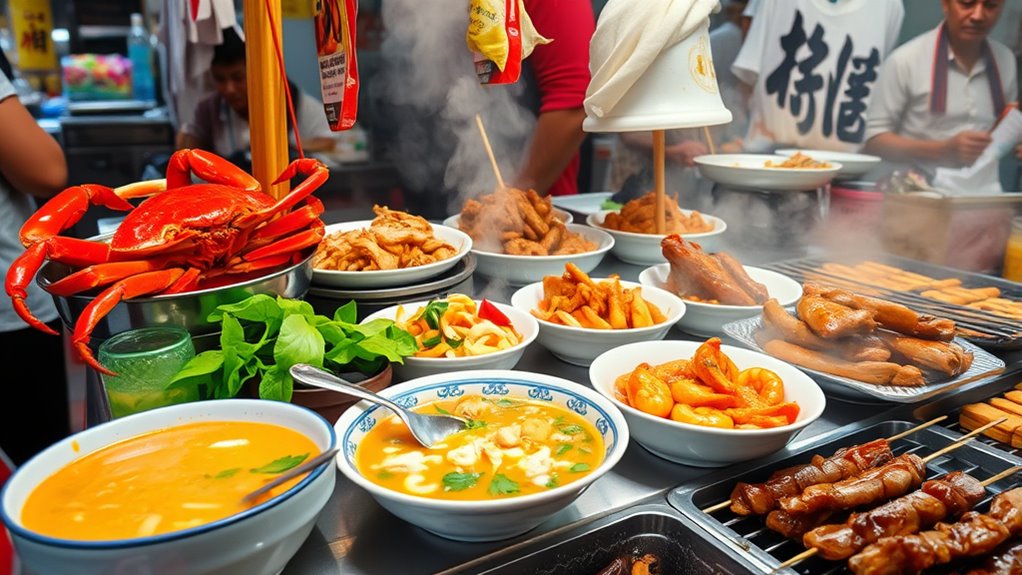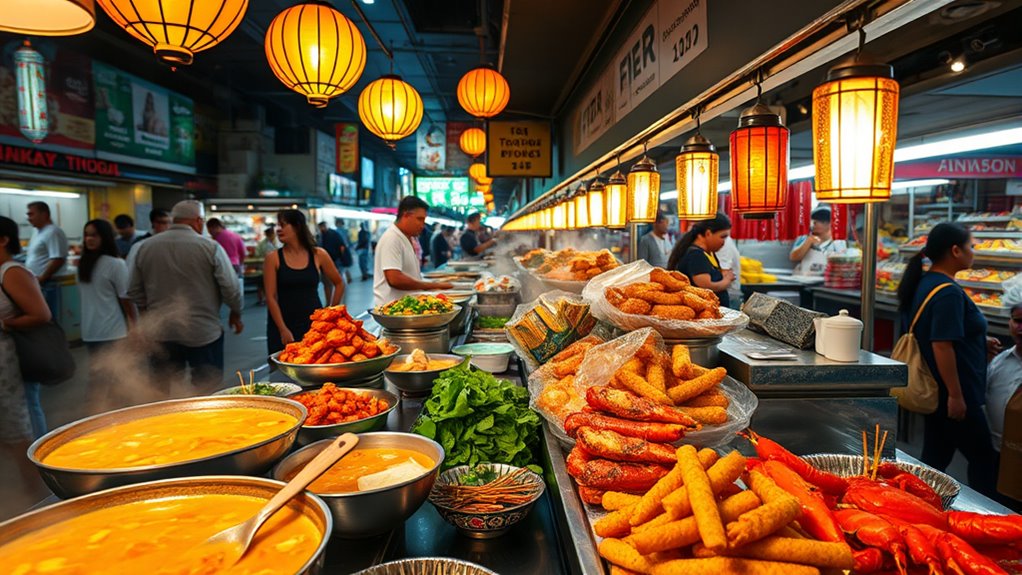Singapore’s cuisine is a lively mix of Chinese, Malay, Indian, and Peranakan flavors, with iconic dishes like chicken rice, chili crab, and laksa. You’ll find bustling hawker centers serving affordable street food that’s rich in tradition and innovation. From breakfast snacks like kaya toast to seafood specialties and modern twists on classic recipes, Singapore’s culinary scene constantly evolves. Keep exploring to discover more about this vibrant, multicultural food paradise.
Key Takeaways
- Singapore’s cuisine is a vibrant fusion of Chinese, Malay, Indian, and Peranakan influences, reflected in iconic dishes like Hainanese chicken rice and laksa.
- Hawker centres serve as cultural hubs offering affordable, traditional street food, many with Michelin recognition, preserving culinary heritage.
- Signature snacks such as kaya toast, roti prata, and Ice Kachang highlight the country’s diverse breakfast and snack culture.
- Seafood, including chili crab and salted egg dishes, plays a central role, showcasing Singapore’s oceanic culinary creativity.
- Modern trends focus on healthier, innovative adaptations while preserving traditional recipes through heritage initiatives and sustainable practices.
Iconic Dishes and National Symbols of Singapore
Singapore’s culinary scene is defined by a handful of iconic dishes that symbolize the nation’s multicultural identity. You can’t visit without trying Hainanese chicken rice, considered the country’s national dish, featuring tender poached chicken served with fragrant rice cooked in chicken stock, often accompanied by chili and ginger sauces. Seafood lovers should savor chili crab, cooked in a sweet, tangy tomato-based sauce that highlights Singapore’s love for fresh seafood. Laksa, a spicy coconut milk noodle soup with prawns and fishcake, showcases Chinese-Malay fusion. Char kway teow, stir-fried rice noodles with seafood and Chinese sausage, offers a hearty, flavorful experience. These dishes reflect Singapore’s diverse cultural influences and are celebrated symbols of its rich culinary heritage.
The Vibrant Street Food and Hawker Culture

The vibrant street food and hawker culture form the heartbeat of Singapore’s culinary scene, bringing together diverse communities through accessible, flavorful dishes served in open-air settings. You’ll find hawker centres everywhere, offering affordable meals that reflect Singapore’s multicultural makeup. Each stall usually specializes in a single dish, like Hainanese chicken rice, laksa, or char kway teow, maintaining focus and quality. Some stalls have even earned Michelin stars, elevating street food’s reputation globally. These centres showcase Chinese, Malay, Indian, and Peranakan influences, creating a colorful culinary mosaic. Most dishes cost between S$3–8, making them accessible to everyone. Here, tradition meets community, ensuring that street food remains an essential part of daily life and Singapore’s identity.
Culinary Influences and Fusion of Flavors

Singapore’s rich culinary landscape reflects centuries of cultural exchange and adaptation. You’ll notice how Chinese immigrants introduced dishes like Hainanese chicken rice and kaya toast, using local ingredients. Malay and Indonesian influences shine through in satay, laksa, and coconut-based flavors. Indian communities contributed roti prata and fragrant biryanis that blend seamlessly into local cuisine. The Peranakan culture creates unique fusion dishes, mixing Chinese and Malay flavors with ingredients like buah keluak and pandan. Modern chefs also experiment, combining traditional ingredients with international techniques to create innovative flavors. Additionally, the use of multifunctional furniture in culinary spaces allows for versatile kitchen layouts that maximize small areas. This blend of influences results in a diverse, vibrant food scene where flavors meld and evolve, reflecting Singapore’s multicultural identity. Each dish tells a story of history, migration, and cultural exchange.
Signature Snacks and Breakfast Traditions

Have you ever wondered what snacks and breakfast treats define Singapore’s vibrant food culture? Here are four essentials you should know:
- Kaya Toast – Toasted bread spread with coconut-egg jam and butter, usually served with soft-boiled eggs and kopi or teh tarik.
- Roti Prata – Flaky, pan-fried flatbread paired with curry, enjoyed as breakfast or late-night snack.
- Kueh – Colorful, bite-sized cakes made from coconut, pandan, or glutinous rice, often enjoyed with tea.
- Shaved Ice (Ice Kachang) – A invigorating dessert topped with syrup, beans, jelly, and condensed milk, perfect for tropical mornings.
These treats reflect Singapore’s multicultural influences and are integral to daily life.
Seafood Specialties and Oceanic Delights

You can’t visit Singapore without trying its seafood specialties, especially the iconic crab variations like chili crab and black pepper crab. At hawker centres, fresh seafood is prepared in countless ways, from grilled stingray to stir-fried noodles with prawns. These oceanic delights showcase the city’s vibrant culinary scene and love for seafood.
Iconic Crab Variations
Crab dishes stand out as some of the most celebrated seafood specialties in Singapore, showcasing a variety of rich, flavorful sauces that highlight the country’s culinary creativity. You’ll find several iconic variations that draw locals and visitors alike.
- Chili Crab: Cooked in a sweet, tangy tomato-based sauce with eggs, it’s a must-try for its bold flavors.
- Black Pepper Crab: Features a peppery, buttery crust, offering a spicy, aromatic profile.
- Salted Egg Yolk Crab: Coated in a rich, savory salted egg yolk sauce, garnished with curry leaves.
- Seafood BBQ: Grilled crabs, squid, and prawns, often served with spicy sambal chili, perfect for outdoor feasts.
These variations showcase Singapore’s inventive approach to seafood, blending tradition with bold flavors. Culinary creativity is a key aspect of Singaporean cuisine, reflected in how these dishes are prepared and presented.
Fresh Seafood Offerings
Singapore’s vibrant seafood scene offers a diverse array of oceanic delights that showcase the country’s rich culinary heritage. You can indulge in signature dishes like chili crab, black pepper crab, and salted egg yolk crab—each highlighting bold flavors and fresh ingredients. Seafood BBQ, featuring grilled stingray, squid, and prawns, is also popular at local stalls. To help you navigate the variety, here’s a quick guide:
| Dish | Key Ingredients | Flavor Profile |
|---|---|---|
| Chili Crab | Mud crab, tomato sauce, chili | Sweet, spicy, tangy |
| Black Pepper Crab | Crab, black pepper, butter | Pungent, savory, peppery |
| Salted Egg Crab | Crab, salted egg yolk, curry leaves | Rich, salty, aromatic |
| Seafood BBQ | Stingray, squid, prawns | Smoky, spicy, savory |
| Fried Hokkien Mee | Prawns, squid, noodles | Umami, savory, hearty |
Enjoy the freshness and bold flavors that define Singapore’s oceanic culinary treasures. Exploring seafood preparation techniques can further deepen your appreciation of these dishes.
Seafood at Hawker Centres
Hawker centres serve as the heartbeat of Singapore’s seafood scene, offering a vibrant array of oceanic delights that showcase local flavors and culinary ingenuity. You can indulge in:
- Chili Crab: Savor mud crabs coated in a sweet, spicy tomato sauce, perfect for sharing during celebrations.
- Black Pepper Crab: Enjoy tender crab in a rich, peppery butter sauce, offering a bold alternative to chili crab.
- Salted Egg Yolk Crab: Taste crabs coated in a savory salted egg yolk sauce, garnished with aromatic curry leaves.
- Seafood BBQ: Relish grilled stingray, squid, and prawns, often served with fiery sambal chili, at lively hawker stalls.
These dishes highlight Singapore’s seafood mastery, blending traditional flavors with local creativity.
Heritage and Evolution of Singaporean Cuisine

You can see how Singapore’s cuisine reflects its diverse cultural roots, blending Chinese, Malay, Indian, and Peranakan influences into unique dishes. Over time, modern adaptations and trends have reshaped traditional recipes, making them healthier and more globally appealing. This evolution highlights how Singaporean food continues to honor its heritage while embracing change.
Cultural Roots and Influences
The rich tapestry of Singaporean cuisine reflects a dynamic history shaped by waves of immigrants and local innovation. You’ll notice how Chinese, Malay, Indian, and Peranakan influences blend seamlessly into your plate. Here’s what makes this culinary mosaic unique:
- Chinese immigrants introduced dishes like Hainanese chicken rice, adapting traditional recipes with local ingredients.
- Malay and Indonesian traditions brought aromatic spices, coconut milk, and dishes such as laksa and satay.
- Indian communities contributed roti prata, biryani, and flavorful curries, enriching the local palate.
- The Peranakan culture fused Chinese and Malay flavors, creating signature dishes like ayam buah keluak.
This melting pot reflects Singapore’s multicultural identity, evolving through generations while maintaining its heritage.
Modern Adaptations and Trends
Singaporean cuisine continues to evolve as chefs and home cooks adapt traditional recipes to contemporary tastes and global influences. You’ll notice modern twists in classic dishes, like lighter versions of laksa and healthier oil choices in char kway teow. Many restaurants fuse local flavors with international techniques, creating innovative dishes that appeal worldwide. Sustainability also plays a role, with hawkers reducing salt and fat, and using vegetable oils. The government promotes preservation through heritage trails and UNESCO recognition, ensuring these culinary traditions endure. Additionally, new ingredients and presentation styles keep the cuisine fresh and exciting. Despite these changes, the essence of Singaporean food remains rooted in its multicultural heritage, blending the old with the new to reflect Singapore’s dynamic, global identity. Incorporating essential oils into culinary practices is also an emerging trend, highlighting how natural ingredients continue to influence modern cooking.
Frequently Asked Questions
How Do Singaporean Dishes Reflect Its Multicultural Society?
You can see Singaporean dishes reflect its multicultural society through the variety of flavors and ingredients used. For example, dishes like laksa blend Chinese and Malay influences, while satay showcases Malay traditions. Hawker stalls feature Chinese, Indian, and Peranakan foods side by side, highlighting cultural integration. This diversity offers you a rich culinary experience, where each dish tells a story of Singapore’s multicultural heritage and its ability to fuse different culinary traditions seamlessly.
What Role Do Hawker Stalls Play in National Identity?
Hawker stalls are the beating heart of Singapore’s identity, embodying its vibrant multicultural spirit. You see locals and visitors alike flocking here, experiencing the rich tapestry of Chinese, Malay, Indian, and Peranakan flavors in every bite. These stalls foster community, preserve tradition, and keep the soul of Singapore alive. Their affordability and diversity make them more than just food spots—they’re a symbol of unity and resilience in your nation’s fabric.
How Has Singaporean Cuisine Evolved With Modern Culinary Trends?
You see Singaporean cuisine evolve as it blends traditional flavors with modern trends. Chefs adapt recipes by reducing salt and fat or introducing new ingredients, making dishes healthier and more appealing globally. Contemporary restaurants often fuse local flavors with international techniques, reflecting Singapore’s global outlook. This evolution preserves heritage while embracing innovation, ensuring your favorite dishes stay relevant and exciting for both locals and visitors alike.
What Are the Health-Conscious Adaptations in Traditional Recipes?
You’ll notice that many hawkers now use healthier oils like vegetable oil instead of pork lard in dishes like char kway teow, reducing saturated fat. They also cut back on salt and sugar, making recipes more suitable for health-conscious customers. Some stalls offer steamed or grilled options instead of fried, and ingredients like fresh vegetables are added more often, helping you enjoy traditional flavors without compromising your health.
How Does Singapore Promote and Preserve Its Hawker Culture Globally?
Singapore is like a proud gardener, nurturing its hawker culture to blossom worldwide. It actively promotes this heritage through UNESCO inscription efforts, heritage trails, and government support. You can experience authentic street food at designated hawker centers, while international awards and media spotlight help elevate its global status. This dedication guarantees that Singapore’s beloved hawker scene remains vibrant and accessible, like a treasured jewel shining brightly on the world stage.
Conclusion
As you explore Singapore’s vibrant streets, you’re greeted by the irresistible aroma of sizzling satay and fragrant laksa, weaving a tapestry of flavors that tell a story of cultural harmony. The bustling hawker stalls burst with colors and sounds, inviting you to taste centuries of tradition in every bite. Embrace this culinary mosaic, where every dish reflects the city’s rich history and lively spirit—an unforgettable feast for your senses.










